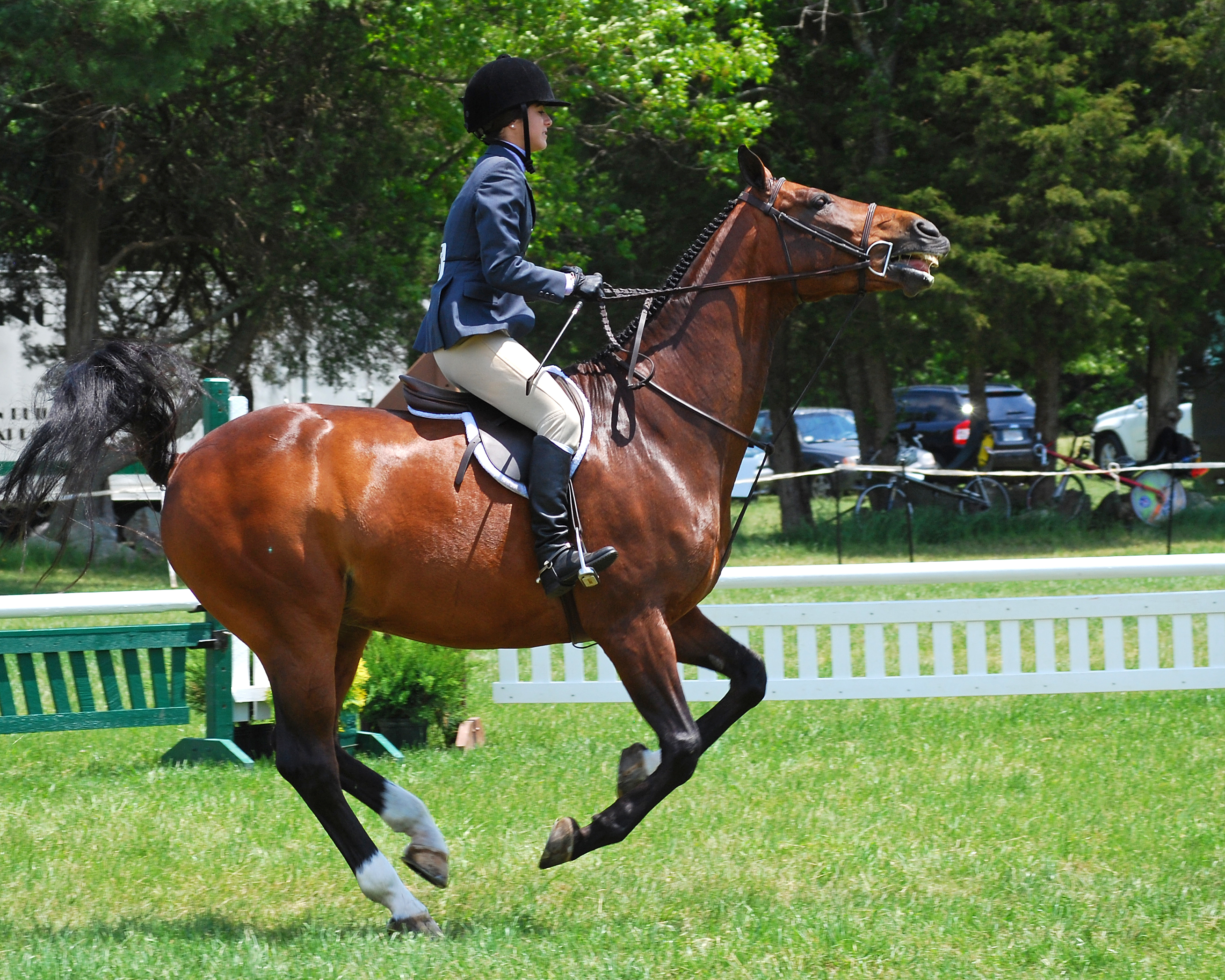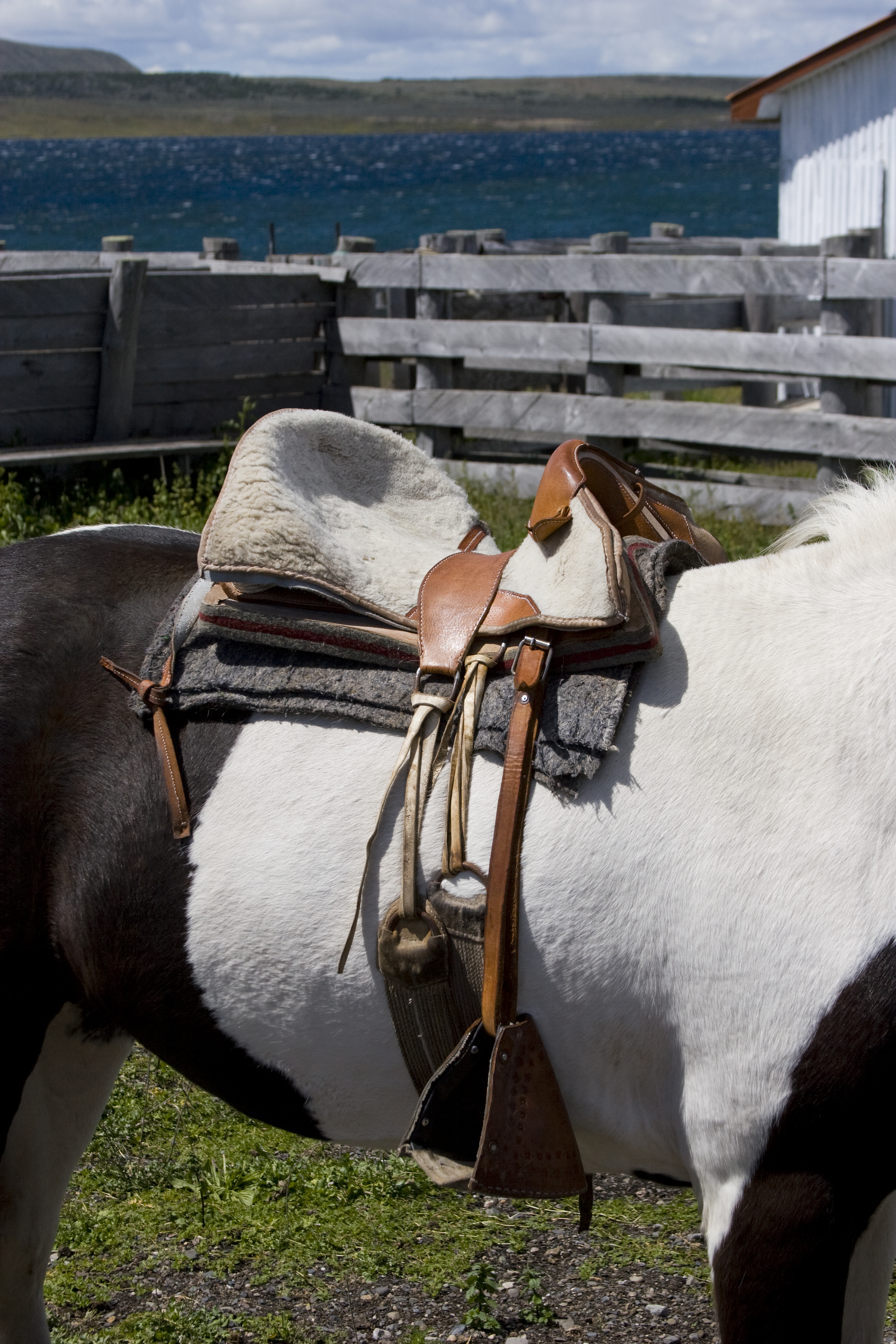|
Gogue
The Gogue is a piece of horse tack used for training purposes, and is very popular in Europe, with a similar place in training regimes as side reins. Its purpose is to encourage the horse to raise the neck, free the shoulders and engage the hocks, so that he may develop the correct muscles for a rounded topline. In function, the Gogue is similar to a bearing rein, and opposite to a chambon or standing martingale. History The Gogue was developed by the French horseman René Gogue (1903-1988), who graduated from the French Military Academy of Saumur. René Gogue invented his rein in 1948 and immediately became an adviser of famous European riders. He theorized that poorly or unschooled horses had three points of resistance: the poll, the mouth, and the base of the neck. The triangular system was designed to release that tension. Fittings of the Gogue The Gogue has two fittings: the independent and the command. The Independent Fitting This is used for longeing or free-schoolin ... [...More Info...] [...Related Items...] OR: [Wikipedia] [Google] [Baidu] |
Chambon And Gogue On Horse
A chambon is a piece of horse tack. It is a strap that runs forward from the bottom of the Girth (tack), girth or surcingle, and forks. The forks continue to a ring on either side of the bridle or halter, at the base of the Bridle, crownpiece. Running through those rings, the forks follow the Bridle, cheekpieces to the Bit (horse), bit. They may attach to the bit or pass through the bit rings and attach to themselves below the horse's neck. A chambon prevents the horse from raising its head beyond a fixed point. Raising the head causes the length of the chambon along the cheekpieces to shorten and thus puts reciprocal pressure on the horse's mouth and on the horse's Poll (livestock), poll. Horses generally dislike pressure behind the poll and learn to release the pressure by lowering their head, and when in motion, this encourages the horse to relax its back and bring its hindquarters further under its body, thus encouraging collection (horse), collection. The chambon has the ... [...More Info...] [...Related Items...] OR: [Wikipedia] [Google] [Baidu] |
Chambon
A chambon is a piece of horse tack. It is a strap that runs forward from the bottom of the girth or surcingle, and forks. The forks continue to a ring on either side of the bridle or halter, at the base of the crownpiece. Running through those rings, the forks follow the cheekpieces to the bit. They may attach to the bit or pass through the bit rings and attach to themselves below the horse's neck. A chambon prevents the horse from raising its head beyond a fixed point. Raising the head causes the length of the chambon along the cheekpieces to shorten and thus puts reciprocal pressure on the horse's mouth and on the horse's poll. Horses generally dislike pressure behind the poll and learn to release the pressure by lowering their head, and when in motion, this encourages the horse to relax its back and bring its hindquarters further under its body, thus encouraging collection. The chambon has the opposite function to an overcheck or bearing rein, which is used to raise the ... [...More Info...] [...Related Items...] OR: [Wikipedia] [Google] [Baidu] |
Horse Tack
Tack is equipment or accessories equipped on horses and other equines in the course of their use as domesticated animals. This equipment includes such items as saddles, stirrups, bridles, halters, reins, bits, and harnesses. Equipping a horse is often referred to as tacking up, and involves putting the tack equipment on the horse. A room to store such equipment, usually near or in a stable, is a tack room. Saddles Saddles are seats for the rider, fastened to the horse's back by means of a '' girth'' (English-style riding), known as a ''cinch'' in the Western US, a wide strap that goes around the horse at a point about four inches behind the forelegs. Some western saddles will also have a second strap known as a ''flank'' or ''back cinch'' that fastens at the rear of the saddle and goes around the widest part of the horse's belly.Price, Steven D. (ed.) ''The Whole Horse Catalog: Revised and Updated'' New York:Fireside 1998 p. 167-178 It is important that the saddle be com ... [...More Info...] [...Related Items...] OR: [Wikipedia] [Google] [Baidu] |
Side Reins
Side reins are equipment used when longeing a horse, running from the bit (horse), bit of the bridle to the saddle or surcingle. As a horse training tool, they encourage flexion and softness in the horse's mouth. For Longeing, longe line work with a rider up who does not carry ordinary riding reins, they help calm and settle the animal. However, they are a tool best used by experienced handlers; used improperly they may unduly restrict the horse's movement or cause an accident. The side rein Side reins are made of leather or webbing, sometimes with added elastic, and have several rings or holes for buckles along their length. They are easily adjusted. Some designs have adjustable buckles and attach to the bit with a snap, other designs run through the bit ring, then fold back on themselves and snap to their own rings. Side reins may be completely of solid material, or they may have an elastic or rubber ring insert. Each design has its advantages and disadvantages. Designs ... [...More Info...] [...Related Items...] OR: [Wikipedia] [Google] [Baidu] |
Bearing Rein
A bearing rein, known today as an overcheck or a checkrein, is a piece of horse tack that runs from a point on the horse's back, over the head, to a bit. It is used to prevent the horse from lowering its head beyond a fixed point. A variation called a side check passes beside the ears through loops at the top of the bridle cheekpieces. It can be attached to the surcingle of a horse harness, or to the harness saddle. An overcheck or bearing rein shares some function with side reins, draw reins, and the de Gogue, and has the opposite function to a chambon and martingale. It can be attached to the same bit as the reins, or to a second, separate bit. Use The modern overcheck is often a necessary piece of safety equipment for certain types of harness and is an aid to the driver in keeping a horse's head properly positioned. An overcheck has a practical purpose; if a horse lowers its head too far when in harness, particularly if moving quickly, it can catch the bridle on th ... [...More Info...] [...Related Items...] OR: [Wikipedia] [Google] [Baidu] |
Martingale (tack)
A martingale is any of several designs of tack that are used on horses to control head carriage. Martingales may be seen in a wide variety of equestrian disciplines, both riding and driving. Rules for their use vary widely; in some disciplines they are never used, others allow them for schooling but not in judged performance, and some organizations allow certain designs in competition. The two most common types of martingale, the standing and the running, are used to control the horse's head height, and to prevent the horse from throwing its head so high that the rider gets hit in the face by the horse's poll or upper neck. When a horse's head gets above a desired height, the martingale places pressure on the head so that it becomes more difficult or impossible to raise it higher. The standing martingale The standing martingale, also known as a "tiedown" or a "head check",The Pony Club Association of NSW, “Handbook”, Simpson & Sons, 1982 has a single strap which is attac ... [...More Info...] [...Related Items...] OR: [Wikipedia] [Google] [Baidu] |
Girth (tack)
A girth, sometimes called a cinch (Western riding), is a piece of equipment used to keep the saddle in place on a horse or other animal. It passes under the barrel of the equine, usually attached to the saddle on both sides by two or three leather straps called billets. Girths are used on Australian and English saddles, while western saddles and many pack saddles have a cinch, which is fastened to the saddle by a single wide leather strap on each side, called a latigo. Retrieved on 17 March 2009 Although a girth is often enough to keep a well-fitting saddle in place, other pieces of equipment are also used in jumping or speed sports such as polo, |
Poll (horse)
The poll is a name of the part of an animal's head, alternatively referencing a point immediately behind or right between the ears. This area of the anatomy is of particular significance for the horse. Specifically, the "poll" refers to the occipital protrusion at the back of the skull. However, in common usage, many horsemen refer to the poll joint, between the atlas (C1) and skull as the poll. The area at the joint has a slight depression, and is a sensitive location. Thus, because the crownpiece of a bridle passes over the poll joint, a rider can indirectly exert pressure on the horse's poll by means of the reins, bit, and bridle. Importance of the poll in riding The poll is especially important in riding, as ''correct'' flexion at the poll joint is a sign that the horse is properly on the bit. Over-flexion, with the poll lowered and the neck bent at a cervical vertebra farther down the neck, is usually a sign that the horse is either evading contact or that the rider is tr ... [...More Info...] [...Related Items...] OR: [Wikipedia] [Google] [Baidu] |
Rollkur
Rollkur or hyperflexion of the horse's neck is defined as "flexion of the horse's neck achieved through aggressive force" and is banned in International and Olympic sanctioned equestrian sports by the governing body, the International Federation for Equestrian Sports (FEI). The FEI recognises a distinction between rollkur and the riding of the horse in a deep outline not achieved by force. Rollkur has been used by dressage and show jumping riders. The technique has been controversial for some time; petitions and boycotts (including a threatened boycott of the London 2012 Olympics) have been created to ban the practice. The FEI moved to ban the practice following the release of video of Swedish dressage rider Patrik Kittel using rollkur during a competition warm-up, where the horse's tongue appeared to turn blue as a result of the manoeuvre. Usage Despite the official FEI rules of dressage, which state that "the head should remain in a steady position, as a rule slightly in front ... [...More Info...] [...Related Items...] OR: [Wikipedia] [Google] [Baidu] |



